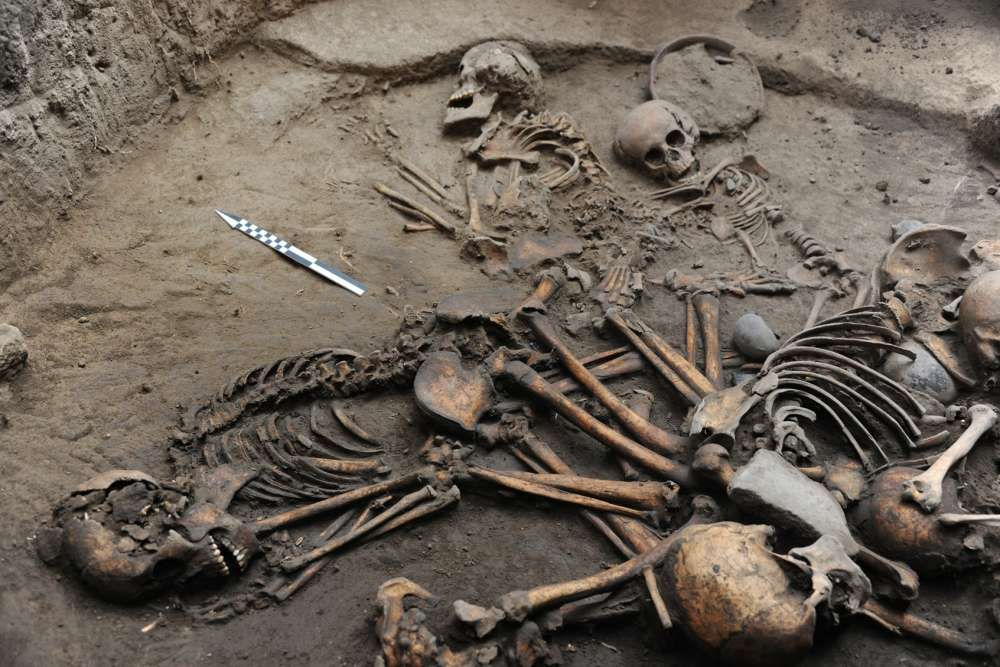In an extraordinary turn of events, a remarkable discovery was made beneath the unassuming grounds of a village school in Cambridgeshire, England. Hidden for centuries beneath the surface, an Anglo-Saxon cemetery dating back to the 6th century CE was uncovered, revealing a wealth of historical treasures from a bygone era. This astonishing excavation, which unearthed the remains of over 100 individuals, has offered an unprecedented glimpse into the burial practices and daily lives of the Anglo-Saxon community that once thrived in this region.
The Pierced Skull: A Fascinating Connection to the Past
Among the discoveries, one artifact stood out as particularly mesmerizing—a woman’s skull, pierced by a golden bar running from the base to the crown. This haunting yet fascinating find serves as a striking reminder of the interplay between ancient history and the modern world. Astonishingly, it was revealed that a gas line had been laid through this very skull, illustrating the profound and sometimes jarring intersection of our modern infrastructure with the remnants of ancient civilizations.

The image of the pierced skull not only captures the imagination but also underscores the fragility and endurance of history. It serves as a powerful symbol of how the past continues to coexist with the present, offering lessons and insights for future generations. Such discoveries compel us to reflect on the delicate balance between progress and preservation.
Unlocking the Secrets of the Past
The excavation of this Anglo-Saxon burial site has proven to be an invaluable resource for archaeologists and historians alike. By carefully studying the skeletal remains and associated artifacts, researchers have been able to glean vital information about the health, diets, and societal organization of this ancient community. For example, analyses of bones and teeth provide clues about nutrition, disease, and even the physical demands of daily life in the Anglo-Saxon era.
Beyond the physical evidence, the cemetery also offers insights into the cultural and spiritual beliefs of the time. The presence of grave goods, the positioning of the bodies, and the variations in burial practices reflect the values and traditions of the Anglo-Saxons. Each burial tells a story, providing a window into the lives of individuals and the community as a whole.
The Importance of Cemetery Excavations
The study of ancient burial grounds plays a crucial role in understanding human history. Cemeteries serve as silent witnesses to the customs, beliefs, and social hierarchies of the past. They reveal not only how people lived but also how they honored their dead—a practice that often reflects broader cultural norms and values.
The Oakington cemetery, where the Anglo-Saxon remains were found, has emerged as a treasure trove of historical knowledge. Its discoveries shed light on the complexity of life during the early medieval period, including insights into gender roles, familial ties, and community structure. For instance, the presence of certain grave goods, such as weapons or jewelry, may indicate the status or occupation of the deceased, while the orientation of the burials can reveal religious influences.
Preserving the Echoes of History
The discovery of the Anglo-Saxon cemetery, particularly the enigmatic skull pierced by a golden bar, underscores the importance of archaeological research in preserving our cultural heritage. Such sites hold the potential to unlock countless mysteries of the past, enriching our understanding of human history and connecting us to those who came before us. They remind us of the shared humanity that transcends time, inviting us to explore the common threads that bind us together.
As we uncover these ancient secrets, it becomes increasingly clear that preservation is not merely a matter of safeguarding artifacts—it is a commitment to honoring the stories of our ancestors. Each discovery adds another chapter to the narrative of human existence, offering lessons in resilience, creativity, and the enduring nature of human curiosity.
A Call to Action for Future Generations
The excavation at Oakington serves as a poignant reminder of the need to prioritize the exploration and preservation of archaeological sites. As modern development continues to expand, the risks to these historical treasures grow. It is vital that we balance progress with a deep respect for the past, ensuring that these irreplaceable resources are protected for future generations.
Through ongoing research and education, we can ensure that the echoes of the past continue to resonate. By sharing these discoveries with the world, we inspire a sense of wonder and appreciation for the rich tapestry of human history. Each artifact, skeleton, and relic represents a piece of the puzzle, contributing to a fuller understanding of where we come from and where we are headed.
Conclusion
The Anglo-Saxon cemetery in Cambridgeshire, with its captivating revelations and hauntingly beautiful pierced skull, stands as a testament to the power of archaeology to connect us with our shared past. These discoveries are more than just remnants of history—they are bridges between eras, linking the lives of ancient peoples to our own. They remind us that while centuries may separate us, the human experience is universal, bound by the same questions, struggles, and aspirations.
As we move forward, let us embrace the lessons of the past with open hearts and minds. By preserving these ancient sites and continuing to uncover their secrets, we not only honor those who came before us but also enrich the world for those who will follow. Through this ongoing dialogue with history, we keep its stories alive, ensuring that the legacy of our ancestors endures for generations to come.





